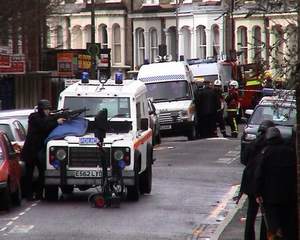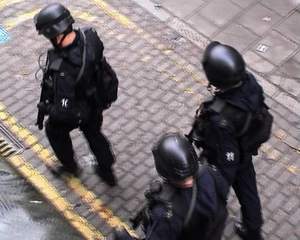Run, Eli, Run! - Notes On The Hackney Siege
With the Hackney Siege now its fourteenth day, locals Matthew Hyland and Jamie King visited the scene to sample the fallout of preventative urban policing.
'You must be used to this sort of thing by now. You live here.' [1]
Perhaps the most impressive effect of the Hackney Siege has been its production of a generalised, weary acquiescence to siege engines. Last weekend's Observer column smirking about the besieging-of-Eli as tourist attraction couldn't have been less well observed. As the 'standoff' drags on, the militarization of the streets is both more and more triumphalist and less and less noticeable. Residents thread their lives around the barricades of a controlled area that grows day by day, and around the physical presence of body-armoured, submachine gun-toting police. Throughout the entire 'drama', The Cock Tavern, a pub at the outer perimeter of the besieged area (the intersection of Sylvester Path and Mare Street), has stayed open. Drinkers step out into the police cordon before making their way home. They know the hostilities are not for local viewing. The curious among them are told to watch their televisions. The Hackney Siege is conducted discreetly, shrinking from view with a stealth disproportionate to its scale. At the time of writing the cops have stopped trying to keep Eli awake with air raid sirens, the helicopters have gone. Everyday life and the state of siege thrive cheek by jowl.
'At least you won't be getting burgled tonight.' [2]Zones of restriction are moved repeatedly: the excuse always has to do with the 'line of fire' just beyond the cordons. Yesterday, some part of a street was deemed safe, members of the public were allowed to stray into it willy-nilly; today, somehow, Eli's firepower has increased, his range expanded. One police officer, questioned about the cordons' profligate growth, strays from the party line: 'It's about complete restriction.' Remonstrations about the impossiblity of a growing line of fire are met with blank, uncomprehending stares. The new police power to redesign residents' movements spontaneously, to designate preemptively the dangerousness of this or that action or person, has become so familiar as to meet with resignation.

Meanwhile crime production has never been so low; without having to use any of their own police Hackney has suddenly shot to the top of the zero tolerance charts; just stick the police of the surrounding boroughs on permanent rations of 'double bubble' and watch the hygiene of the siege do its work. A whole zone cauterised. The council could never have afforded this using conventional methods, but plug in a gunman, job done [...] This is instant spatial sterilisation.' [3] The 'Armed' Man
'He's got enough ammunition in there to fill a bath. And maybe two hand grenades.' [4]
Residents on the scene of the initial shootings heard six shots fired by Eli, with anywhere between fourteen and twenty answering shots from the armed 'response' unit that was, in fact, acting preemptively (see below.) A day later, by now under siege from variously armed members of the law enforcement community, Eli threw a single handgun out of the window. Did this not suggest the discarding of a spent and empty weapon? And, if so, how was it that – according to the police - Eli still came to be firing shots some days later? Was he carrying multiple weapons in his daily business as a London gangster? Or did the 'hostage' (again, see below) supply him with more weaponry from his own personal armoury? 'Assumptions breed around the site of siege: assume everyone in Hackney is packing at least two guns. You just don’t know, do you?' [5] The 'Hostage'
Piqued by comments from the police that Eli hailed from Brixton, disinterested observers on the scene remarked early on that the likelihood of there being another person in the besieged house seemed high: was it not logical that Eli would have been visiting somebody, or that he would have used a friend's house as a safe refuge? These observers were told with derisive laughter that Eli was alone. Only some three days later was it admitted that there was a second man in the flat.
Unconfirmed rumours emanating from the police suggested that this bystander/accomplice had been in a 'crack-induced stupor' (!) for the previous three days before waking up to discover himself to be, in fact, Eli's hostage. Although this unlikely prehistory was quickly discarded, the notion that the second party was Eli's 'hostage' was maintained. The improbability of this was only confirmed by the hostage's 'surprise escape', apparently effected while Eli's attention was distracted. By now it was all but clear that the friend who had, perhaps, agreed to keep Eli company during his besiegeing had grown tired of the increasing barrage of harassment and privations (including nightly air-raid sirens, starvation, freezing cold, and constant discussions with the police) and decided to quit the scene. The outpouring of empathy with the Hackney Hostage was overwhelming for as long the 'hostage' designation remained intact. However, even before the end of this honeymoon period, at least one police office was happy to confirm that the hostage was never, in fact, a hostage at all, but a 'mate' of Eli's who has now been duly 'nicked.'
Anticipatory Retaliation
'His character is quite volatile; he has quickness of temper and together with his possession of firearms that is an alarming trait.' [6]
The besieging of Eli Hall began with an attempt to repossess his car, which had been involved in a shooting in August last year. When the car was spotted in Hackney months later, police repo men arrived to take it away 'for forensic purposes', accompanied by an armed 'response' unit. Clearly, the meaning of 'response' takes on a whole new dimension here. The cop gunmen weren't intervening in an existing firearms situation: they were initiating an armed confrontation on the basis of Eli's personal profile, which supposedly suggested that if they hadn't started it, he might have done. (This fact also sheds some light on Commander Quick's endlessly avowed concern to avoid bloodshed at all costs: it's not difficult to guess the likely consequences of surrounding a man regarded by the police themselves as armed and 'volatile' with cops, guns and megaphones. By way of further exacerbation, operations commenced with the storming of the wrong address.)

The Hackney Siege continues the blurring of the line between armed response and tooled-up anticipatory retaliation. It is an unusually dramatic example of the recent tendency to control subjects profiled as 'risky' using pre-emptive methods. Rather than apprehending those responsible for particular criminal acts, policing strikes first against anyone displaying potentially 'criminal' tendencies. At the apparent centre of this siege is a figure of whom next to nothing is known but about whom, since he was accosted by a group of armed, uniformed men, anything can be said, and to whom, it seems, anything may be done. Casual pronouncements on Eli's fate are made hour by hour. Equally casual are the ad hoc pronouncements which, for the indefinite duration of the siege, skew and rearrange the lives of those around him.
The Hackney Siege is now in its 14th day. 'Disinterested observers' Matthew Hyland and Jamie King are current residents of Mare Street, Hackney. Photographs supplied by local resident Louise Oldfield.
MAP
(Arrow marks rough epicenter of the siege.)
http://www.streetmap.co.uk/streetmap.dll?G2M?X=534868&Y=184844&A=Y&Z=1
FOOTNOTES
[1] Unattributed member of the 'not from round here' police unit. [2] ibid. [3] Benedict Seymour, private correspondence, 07 January 2003. Disinterested observers report that 'double bubble' is police slang for 'overtime'. It is not known whether there is an equivalent correlate for 'toil and trouble.' [4] Unattributed member of the SO19 police unit. [5] Benedict Seymour, op. cit. [6] Borough Commander Quick, The Evening Standard, 07 January, 2003.
Mute Books Orders
For Mute Books distribution contact Anagram Books
contact@anagrambooks.com
For online purchases visit anagrambooks.com






